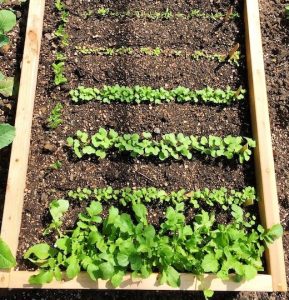by Ken Lain, the mountain gardener
Poetry to a beloved dog
It’s been a sad week at the Lain casa. Baja, our 15 year-old chocolate Lab, passed away on Thursday. 🙁 I hope that you will indulge my attempt at some dog – loving poetry as a tribute to this most beloved member of the Lain family.

Baja – Treasured Friend
(from my tear-soaked keyboard)
We lost a treasured friend today our silky chocolate lab who’d lay her gentle head upon my knee
and share her silent thoughts with me.
She’ll come no longer to our call retrieve no more her favorite ball; a voice far greater than our own has called her to His golden throne. Although our eyes are filled with tears, we thank Him for the happy years of love and loyalty she spent down here.
When it’s time for me to go and join her there, this much I know: I shall not fear the transient dark for she will greet me with a bark.
___Rest in Peace, Baja________________________
On to a topic that is sure to lift my spirits: advanced spring planting for local gardens!
Succession Planting is a way to extend your harvest by staggering crop plantings or by  planting varieties with staggered maturing dates. Here are the 4 best ways to plant in succession:
planting varieties with staggered maturing dates. Here are the 4 best ways to plant in succession:
- Different Vegetables in Succession Some crops, like peas, have short growing seasons and the space they were using can be replanted with a later seasonal crop such as eggplant or summer beans.
- Two Vegetables in the Same Spot There are some seeds of early season vegetables that can be sown at the same time of planting transplants. Intercropping or pairing up plants, is an excellent way to squeeze even more productivity from your vegetable garden. An example is radishes planted at the base of a tomato plant. The radishes will have been harvested and simply a memory of “garden past” as the tomatoes take off in summer’s heat.
- Same Vegetable, Staggered Plantings Space out plantings of the same vegetable every 2-4 weeks. Many vegetables fade after producing their initial crops, setting a heavy yield initially, and then smaller and smaller yields throughout the summer. Rather than planting your entire row of beans all at once and having feast or famine, you can plant part of the row at the beginning of the season and then plant more in about 2-4 weeks. As the first plants start to fade, you can replant that area with beans or use it for a different crop.
The ideal vegetables for succession planting are arugula, basil, beans, beets, broccoli, carrots, chicory, cilantro, corn salad, dill, endive, onions, kale, kohlrabi, lettuce, mizuna, mustard, pak choi, radishes, rutabagas, spinach, Swiss chard, tatsoi, and turnips.
- Same Vegetable, Different Maturity Rates: An easy way to keep your harvest coming is to choose more than one variety of a crop, selecting early, mid, and late season varieties. Sometimes the seed packet will be labeled as such and sometimes you will just have to read the “Days to Maturity” number. Tomatoes, corn, summer squash, and several other vegetables can be staggered throughout the growing season. How to read a seed packet.
Ideal vegetables to sow with different maturity dates are pole beans broccoli, Brussels sprouts, cabbage, carrots, cauliflower, celery, collards, corn, eggplant, kale, melons, peas, summer squash, and tomatoes.
Here’s a link to an excellent 5-minute video on Succession Planting; it’s informative, plus I like the friendly English accent.
[youtube]https://www.youtube.com/watch?v=mbAMYBouo6I [/youtube]
5 Tips to Succession Planting
1. Make sure you have enough seed to get through the season and into fall, especially if you plan to over winter vegetables in the garden. Some seed lasts several years; others need to be fresh for good germination. (Seed viability chart)
2 .Between plantings blend Watters Premium Mulch into the bed. This keeps the soil rich and fertile.
3. Pull out plants that are past their primes. Harvest while at their best, then pull them out to use the space for something else.
4. If you’re an avid seed starter, you can start new transplants in March. Summer squash and cucumbers started in May or June will be ready to transplant as the first plantings wind down. Once those are transplanted, seed fall greens like kale and chard.
5 .Vegetables that like cooler temperatures can be started during the summer if you cool the soil before planting seeds. The easiest way to do this is to thoroughly soak the planting bed and then cover it with a wide board for a couple of days before planting. Lift the board to sow your seed, water again, and then replace the board on top of the sown row. Check daily for germination and remove the board as soon as you see the first signs of green.
For more details, visit us here at Watters Garden Center, your local organic plant seed source.
Ken Lain can be found throughout the week at Watters Garden Center, 1815 W. Iron Springs Rd in Prescott, or contacted through his web site at WattersGardenCenter.com or FB.com/WattersGardenCenter .

